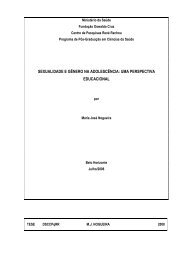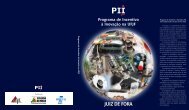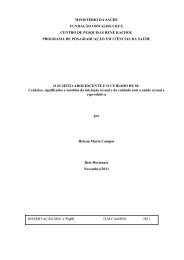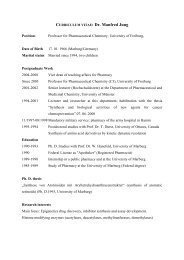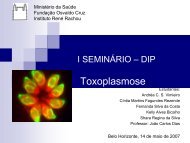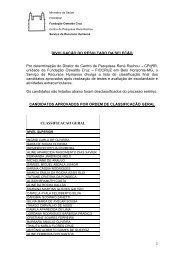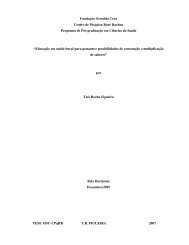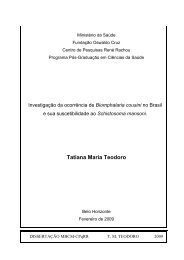Hanseníase: políticas públicas e qualidade de vida de - Centro de ...
Hanseníase: políticas públicas e qualidade de vida de - Centro de ...
Hanseníase: políticas públicas e qualidade de vida de - Centro de ...
Create successful ePaper yourself
Turn your PDF publications into a flip-book with our unique Google optimized e-Paper software.
8.5 The World Health Assembly Resolution 1991<br />
The Forty-fourth World Health Assembly, which met in in Geneva in May 1991, adopted a<br />
resolution to eliminate leprosy as a public health problem by the year 2000, <strong>de</strong>fining<br />
elimination as attaining a level of prevalence below one case per 10 000 population, at the<br />
global level.<br />
This resolution reflected WHO's ongoing commitment to achieving the global elimination of<br />
the disease, and recognised the significant progress ma<strong>de</strong> with multidrug therapy (MDT) and<br />
the consequent reduction in disease prevalence. It also recognised and welcomed the<br />
substantial support from non-governmental organizations (NGOs), and the increased priority<br />
accor<strong>de</strong>d to leprosy control by many of its Member States.<br />
The resolution urged Member States to strengthen their political commitment to leprosy<br />
elimination so as to reach the elimination goal as soon as possible. It requested WHO to<br />
increase it technical support to Member States, and to continue to mobilize and coordinate<br />
resources from NGOs and others in or<strong>de</strong>r to achieve that goal.<br />
By establishing a target for the year 2000, the WHA drew attention to the effectiveness of the<br />
available treatment technology, the need for leprosy-en<strong>de</strong>mic countries and donor agencies to<br />
no longer regard leprosy as a permanent and intracTabela problem, and to redouble their<br />
efforts towards controlling leprosy, and its acceptance as simply another health problem with<br />
a clear solution.<br />
Armed with a clear mandate from its Member States, WHO approached the international<br />
donor community to fund an elimination strategy. By 1995 it had established a global supply<br />
of MDT drugs, a key element of the strategy, which it then ma<strong>de</strong> available free of charge to<br />
all patients around the world.<br />
The elimination of leprosy at the global level was achieved by the end of 2000, after which<br />
WHO then established its own more radical targets of reaching elimination at national and<br />
then sub-national levels. The setting of such targets helped generate and maintain high levels<br />
of political commitment in en<strong>de</strong>mic countries, as well as encouraging donor support for<br />
essential activities such as MDT supply and logistics.<br />
187



